Over the past few months I’ve had a number of readers contact me at my office or via email and inquire about the Nikon 1 gear that I use and why I selected various components. I thought that providing a list of my gear may be of interest and benefit to some readers so here is a “What’s in my bag” article as it pertains to my Nikon 1 gear.
NOTE: Click on images to enlarge.

First of all, my primary camera bag for my Nikon 1 gear is a Tenba Discovery Large Shoulder Bag. I selected this bag for its range of internal dividers, pockets, overall storage capability, and its lower profile. The coffee cup in the photo is to provide a sense of scale. (And yes…my bag is very well used!)

I also like that the top flap opens away from my body making it easy to find gear inside the dividers. I find the lower profile really works well with smaller Nikon 1 gear. This Tenba bag also holds a lot of gear as you’ll see in the next image.
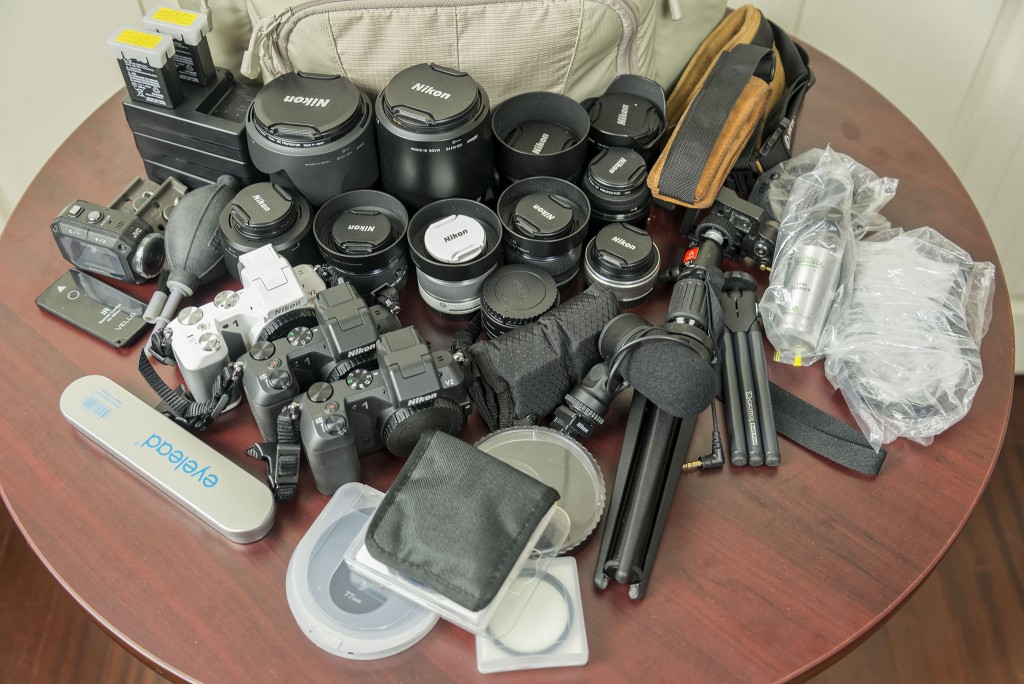
So, what’s in my bag? Here’s a complete list of gear:
• 3 – Nikon 1 V2 mirrorless cameras
• 1 – JVC GC-XA1BU Adixxion Action Camera with charger
• 3 – Nikon 1 CX 10-30 mm f/3.5-5.6 VR lenses (one fitted with a 40.5 mm Vivitar variable neutral density filter, one fitted with a 40.5 mm B+W polarizer, and one with a standard 40.5 mm UV filter)
• 1 – Nikon CX 70-300 mm f/4.5-5.6 VR lens with tripod foot
• 1 – Nikon CX 10-100 mm f/4.5-5.6 PD VR lens
• 1 – Nikon CX 30-110 mm f/3.8-5.6 VR lens
• 1 – Nikon CX 6.7-13 mm f/3.5-5.6 VR lens
• 1 – Nikon CX 32 mm f/1.2 lens
• 1 – Nikon CX 18.5 mm f/1.8 lens
• 1 – Nikon CX 10 mm f/2.8 lens
• 3 – Tamrac N-45 Foam Padded Leather Quick Release Camera Straps
• 3 – Nikon MH-28 battery chargers
• 2 – Nikon EN-EL21 batteries (plus one battery in each camera)
• 1 – Nikon ME-1 shotgun microphone
• 1 – set of Vello auto-focus extension tubes for Nikon 1 (10 mm and 16 mm)
• 1 – 77 mm Nikon polarizing filter
• 1 – 77 mm Marumi variable neutral density filter
• 1 – 52 mm B+W polarizing filter
• 1 – 52 mm Hoya variable neutral density filter
• 1 – Tenba SD card holder with 16 SD cards -mainly SanDisk and a few older Lexar (although I am no longer buying Lexar SD cards due to quality issues), either 16 GB or 32 GB, various speeds based on card age
• 1 – Vello IR remote control for Nikon
• 3 – Manfrotto quick release plates
• 1 – bag of assorted step-up rings ( 72-77 mm and 62-77 mm used most frequently)
• 2 – pairs of Sensei filter wrenches (48-58 mm, 62-77 mm)
• 1 – eyelead sensor cleaning kit
• 1 – Purosol lens cleaner with Pearstone lens cleaning cloth
• 1 – Oben TT-300 table top tripod
• 1 – Giottos Ball.Pod
• 1 – Matin blower
Plus, from time to time I cram in a rain sleeve, and if I’m not worried about it poking out by an inch or two from one of the front pockets, I’ll sometimes pack my Tamrac Zipshot tripod.
I think this detailed listing drives home a couple of key things that I love about using the Nikon 1 system – its size and lightweight!
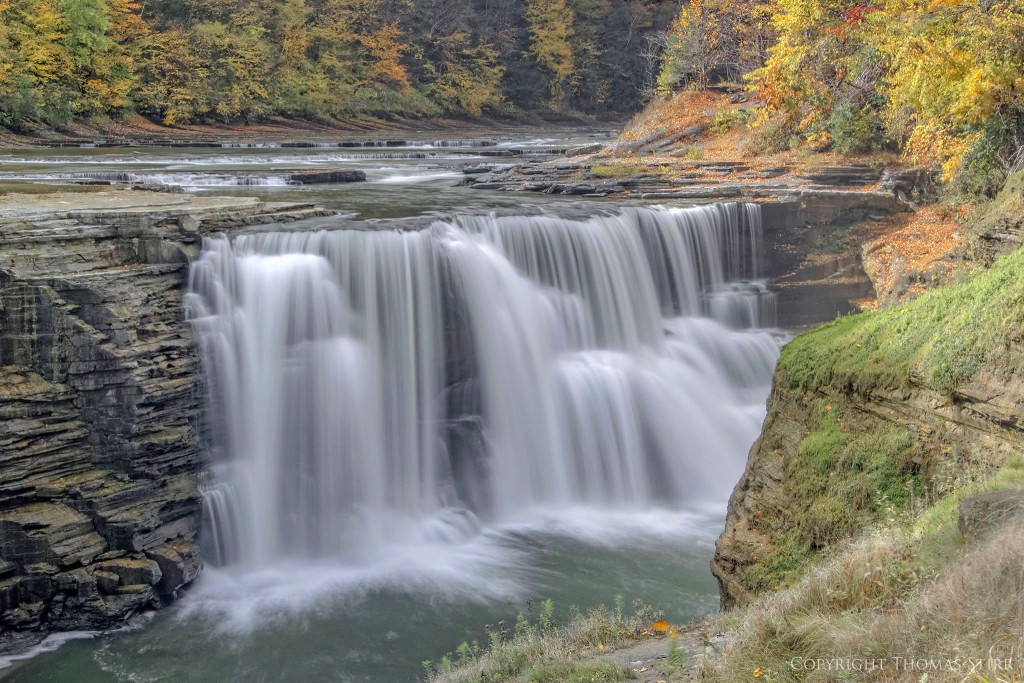

Here’s a quick run-down of some of listed gear, along with some comments about why I chose it, and how I typically use it.
Nikon 1 V2 Camera Bodies
When I use my Nikon 1 V2’s for client work it is usually for safety and industrial videos. I find the cameras are ideal in terms of their size, lightweight and good 1080 HD 30p video capture. The Nikon 1 V2’s meter is almost identical to my Nikon D800 so I can integrate footage from both types of cameras with a minimum of fuss. I often have my D800 and 2 or 3 V2’s recording a scene at the same time to give me a range of angles and perspectives. This can add quite a bit of production value for clients.
Manual focusing on most Nikon 1 lenses needs to be done through the camera body which is a bit of a pain, but it’s just one of those trade-offs that needs to be made when doing video work.
For personal stills shooting I rely on my Nikon 1 gear most of the time and very seldom use my Nikon D800 and FX glass, unless I’m shooting wildlife or birds with my Tamron 150-600 mm.


JVC Adixxion Action Cam
On very rare occasions I need to take video clips underwater, often hand-held or with a small action cam mounted on a miniature tripod. The JVC Adixxion Action Cam is an affordable choice that produces acceptable 1080 HD video. I like this particular camera as it incorporates a standard tripod thread so no ‘unique’ mounts are required for it. I can use it on the same mounts as my Nikon 1 bodies and I can also use my Manfrotto quick release plates on it. (I know this is not a Nikon 1 product…but I keep it in with my Nikon 1 kit)
Nikon 1 CX 10-30 mm f/3.5-5.6 VR lenses (non-PD)
Nikon basically forced people to buy this kit lens when a V2 body was purchased. Rather than sell my additional copies I add speed and functionality to my bag by fitting variable neutral density, polarizing, and UV filters on different lenses. That way I can quickly switch lenses and avoid having to mess around changing filters. The 10-30 mm non-PD lens is the least sharp of all of my Nikon 1 lenses. They do cover a useful focal range and are very lightweight so I use them quite a bit. Working the RAW files in post can help image quality significantly.


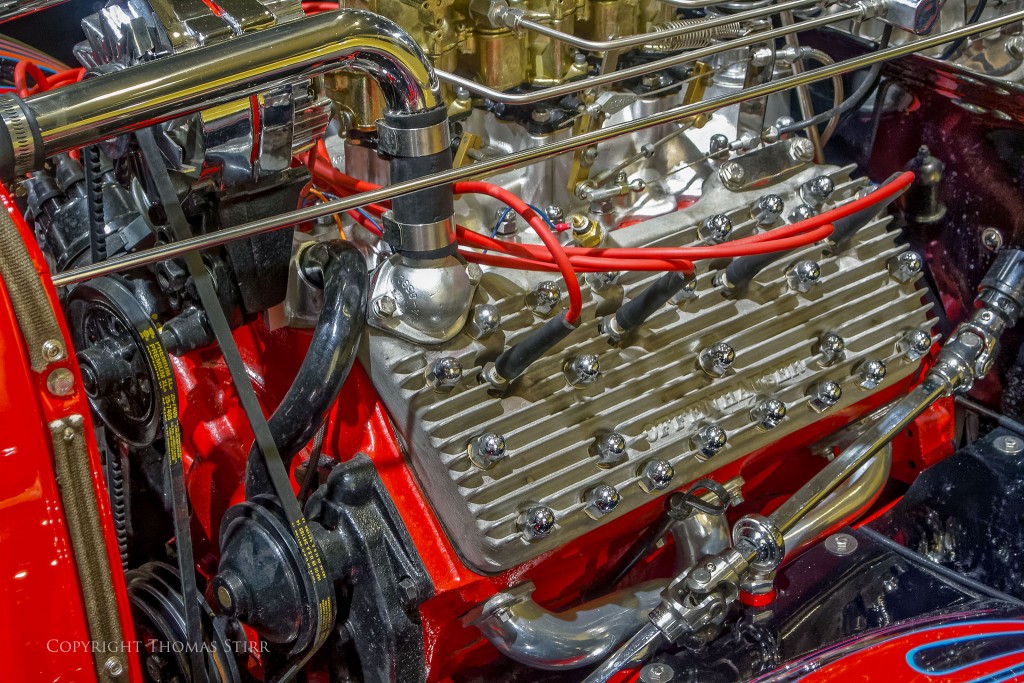
Nikon 1 CX 30-110 mm f/3.8-5.6 VR
This is a surprisingly good lens for the purchase price. It is almost as sharp as my Nikon 1 primes and is my favourite lens to use with extension tubes. When I need to get into very tight quarters when shooting video this lens is the one I use most often with one of my very small tripods. Under these challenging conditions it can produce some amazing results. It is also a great travel lens, delivering good image quality and excellent reach for its diminutive size. The VR is very effective and I used this lens quite a bit in museums while in Greece, often shooting at slower shutter speeds. It also has a fairly short minimum focusing distance which provides additional flexibility.
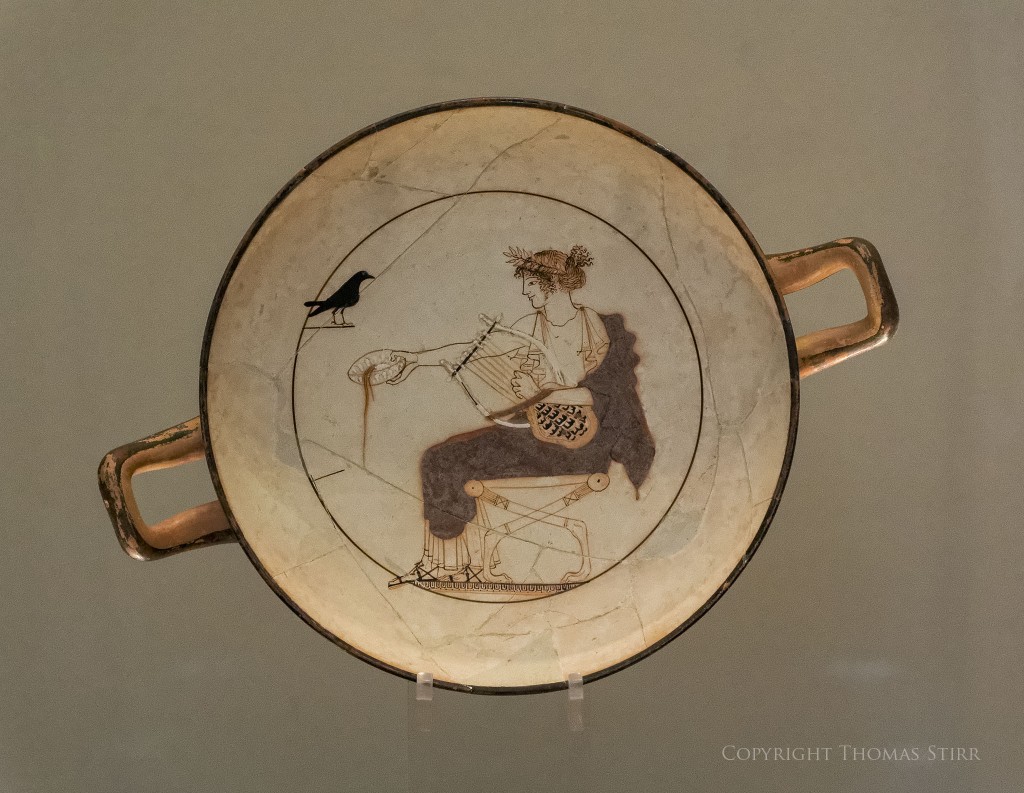
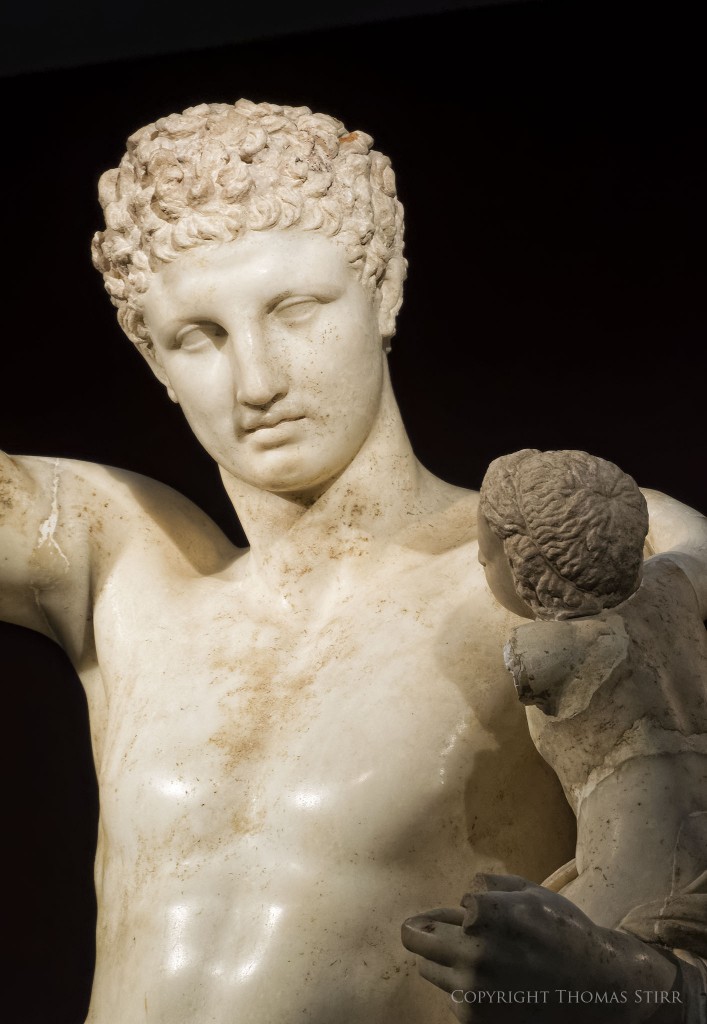

Nikon 1 CX 6.7-13 mm f/3.5-4.5 VR
This is a really nice lens that delivers good sharpness (on par with the 10 mm f/2.8 and 18.5 mm f/1.8 primes) nice colour rendition and VR to boot! It is great as a landscape lens and also comes in very handy when shooting video in tight quarters. I usually have a B+W polarizing filter fitted on mine.


Nikon 1 10-100 mm f/4.5-5.6 PD VR zoom
This is my ‘go to’ lens for Nikon 1 video work. The power zoom provides very good control, is smooth, and very quiet. It is especially effective when doing slow ‘push or pull’ zooms in scenes. The wide focal range gives this lens a lot of flexibility. It’s sharper than the 10-30 mm but falls a bit short of the 30-110 mm in this regard. It is a rather heavy lens so when travelling I typically use the 10-30 mm and 30-110 mm rather than take this lens. A 72-77 mm step up ring allows me to quickly mount either my 77 mm polarizer or variable neutral density filters on it.
Nikon 1 CX 70-300 mm f/4.5-5.6 VR
Without question this is my favourite Nikon 1 lens. It is sharp throughout the focal range, renders colours beautifully and is a joy to use. For birders and wildlife photographers who use Nikon 1 bodies this is a ‘must have’ lens. It is expensive, but worth every penny.

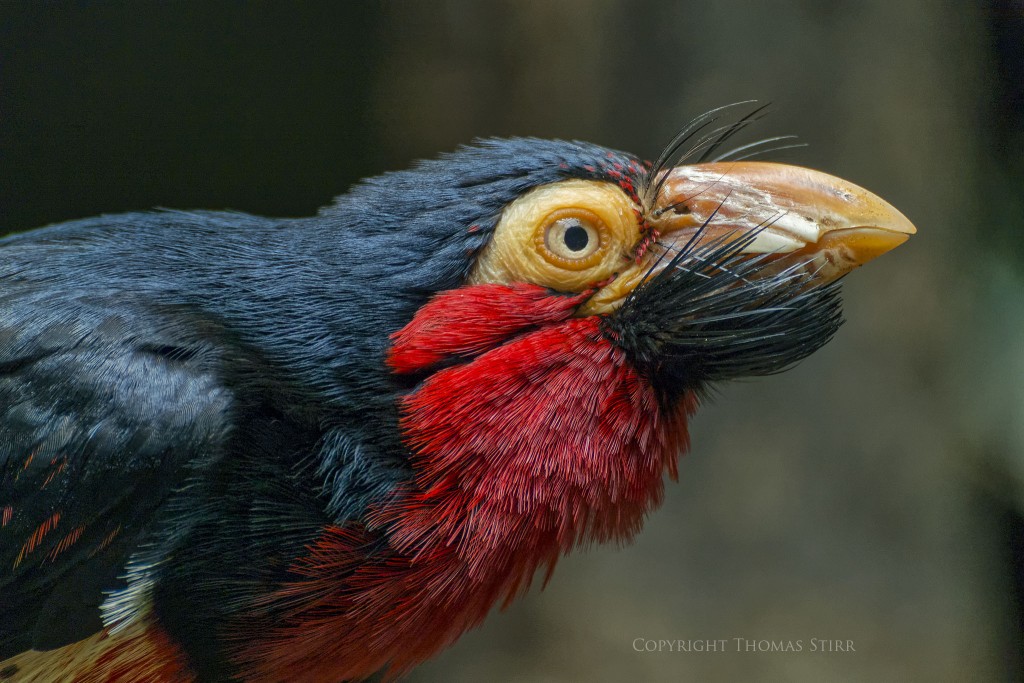


Nikon 1 Primes
Nikon makes three prime lenses for the Nikon 1 system and I own all three of them: 10 mm f/2.8 (efov 27 mm), 18.5 mm f/1.8 (efov 50 mm), and 32 mm f/1.2 (efov 86 mm). As expected all are quite sharp and perform well. I use mine mainly for client videos when working in dark conditions and very seldom take still photos with them.


Nikon ME-1 Shotgun Mic
Perhaps best rated as an ‘average’ performer the ME-1 is small and doesn’t require batteries so it’s a good addition to my bag for general purposes. I often replace this with my Rode VideoMic Pro when I need something a bit better in my bag.
Tamrac N-45 Quick Release Straps
All of my cameras, including my D800, have these straps on them. When working on client projects I often have to switch between taking stills and video clips so having quick release straps is critical for me as I often need to remove straps when using a slider, skater dolly or jib. I find these straps provide a good level of security and comfort.
Vello Auto Focus Extension Tubes for Nikon 1
These tubes are very affordable and provide additional capability to Nikon 1 lenses, especially the 30-110 mm. These are very handy when extreme close-up video clips are required. These extension tubes have plastic flange connections so some care is needed when using them as the flanges are not overly robust. I’m hoping Vello updates these tubes and changes to metal mounts.

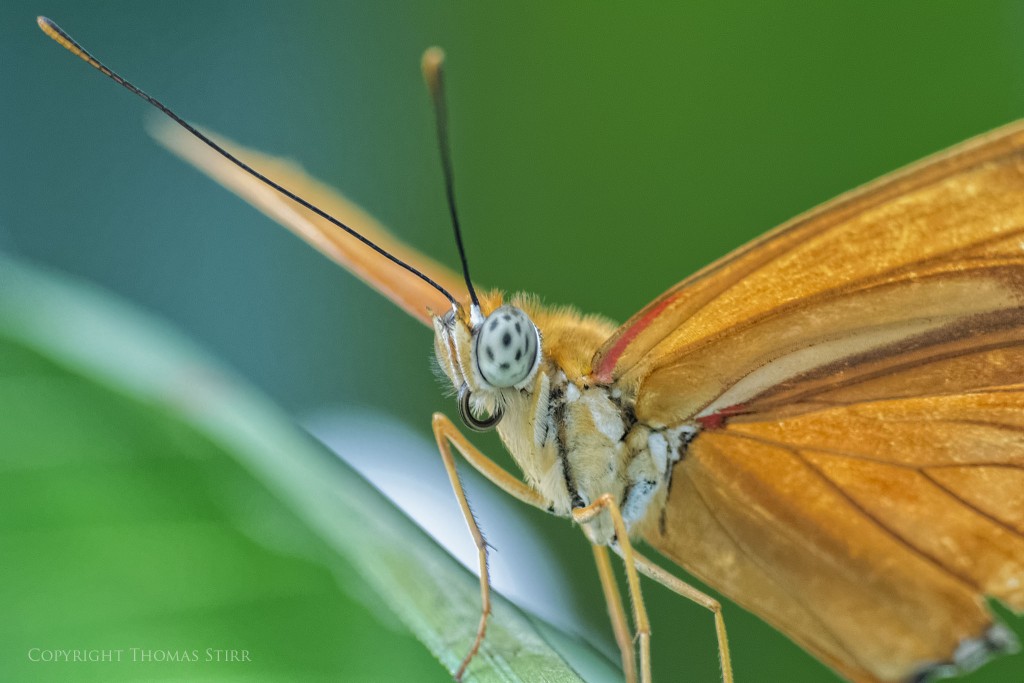
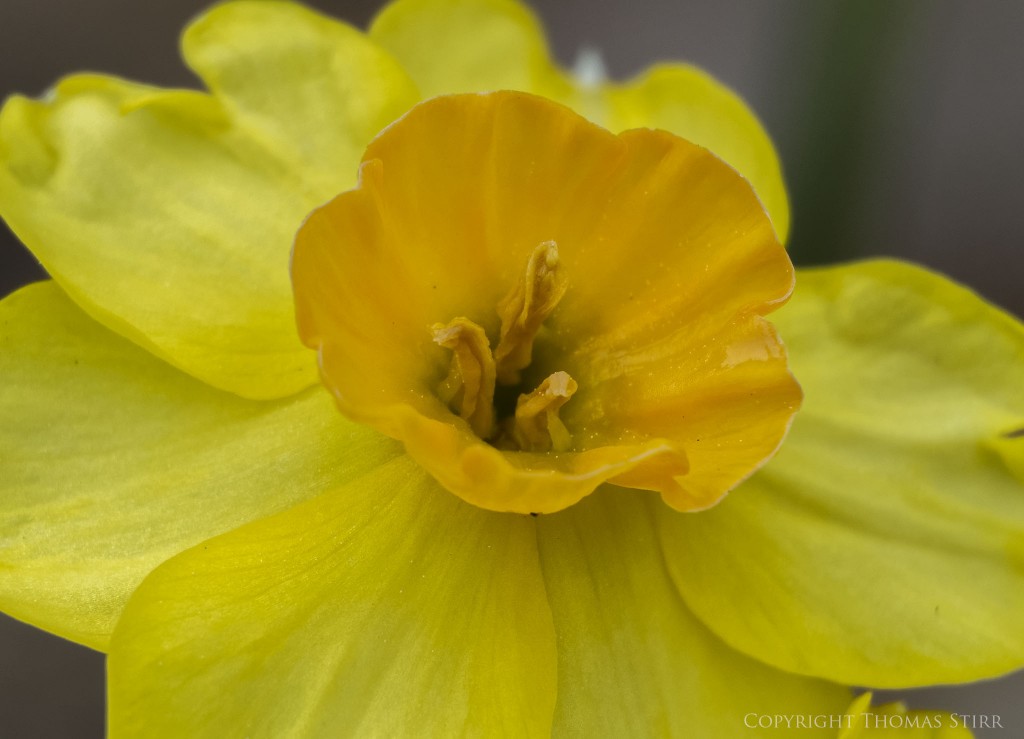
Vello IR remote control
An affordable remote that works well with Nikon 1 cameras for both stills and video.
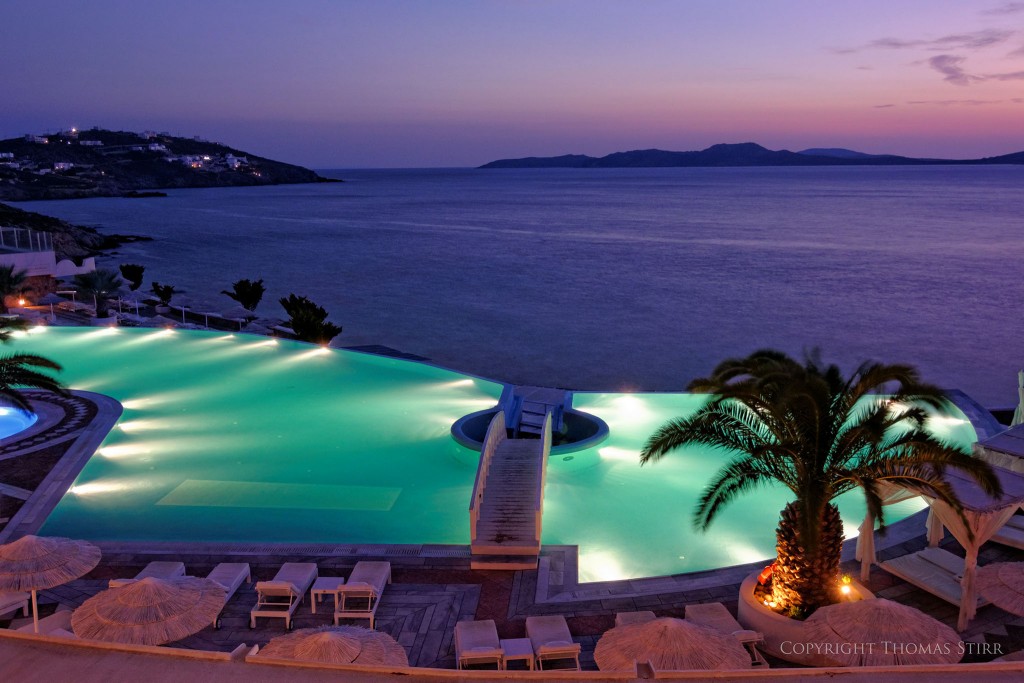
Small Tripods
Packing smaller sized tripods like the Oben TT-300, Giottos Ball.Pod, and the Tamrac Zipshot, adds even more flexibility to Nikon 1 gear. The light weight of the Nikon 1 camera bodies and many of the Nikon 1 lenses means that these small sized tripods are excellent choices as they can provide a good level of stability and take up minimal room in your camera bag.

Overall, I find that I can pack a high degree of video and still photography shooting flexibility into one shoulder bag when using my Nikon 1 gear. The small size and light weight of this gear also makes it a very practical choice for travel photography.
If you enjoyed this article and would like to learn more about the Nikon 1 system, you may want to have a look at our eBook, The Little Camera That Could. It illustrates the capability of the Nikon 1 system through hundreds of original photographs. There is also commentary and tips about the Nikon 1 system.
My intent is to keep this photography blog advertising free. If you enjoyed this article and/or my website and would like to make a modest $10 donation through PayPal to support my work it would be most appreciated. You can use the Donate button below. Larger donations can be made to tom@tomstirr.com through PayPal.
Article and images Copyright Thomas Stirr. All rights reserved. No use, duplication of any kind, or adaptation is allowed without written consent.



Just found this, and enjoyed reading about what you do. I have a Sony A55 which is too bulky for comfortable travel, and, when it developed a cider-related fault while I was overseas, I bought a Nikon 1 J1 to continue my travels. I even successfully used the J1 with a cheap, screw in 2x teleconverter, giving me a 10 – 60 (28-160) capability
Something else I really liked about my J1 and V1 was that low light performance wasn’t as bad as you might expect. I had had a Kodak bridge camera at one point which struggled in average room lighting, and was impressed that I was getting lovely night-time street scenes by normal street lighting thanks to Nikon.
The J1 was so useful that I eventually bought a V1, which I used for a couple of years until the 10-30 lens died, and I didn’t get around to sending it in for repairs.
I’ve mainly used a couple of pocket cameras since, but on a recent trip iinterstate (which involved a presentation at which the Sony would have been vastly out of place) I was able to find a 10-30 lens attached to a J2 body, so the V1 went everywhere on those few days of travel — and the lens died a few days after I got home.
I have been looking at MFT cameras, but find they seem to either be kind of larger Nikon 1 Js or a bit expensive. and not a lot smaller than an APS-C SLR.
I grumble about lack of a tilting or articulating screen on the Nikons, but they are otherwise in many respects the ideal travel and street camera. Like you, I took movies with them (and found the conversion to YouTube friendly MP4 a pain).
The closest equivalent seems to be the Sony RX100 with all the disadvantages of a fixed zoom lens, particularly in its bellows-like action, pumping dirt in and out of the camera. I am surprised that Nikon doesn’t see any potential in a modernised Nikon 1.
Hi Peter,
Thanks for sharing your experiences with Nikon 1 and other cameras. Our Nikon 1 kit did a stellar job for us for the four years that we used it exclusively for both our client work and personal needs. A couple of years ago we found new homes for all of our Nikon 1 cameras, lenses and accessories.
In terms of M4/3 camera you may find that the E-M10 Mark IV, E-M5 Mark III or OM-5 are closer to the size of some Nikon 1 bodies. My wife uses an M.Zuiko 14-150 f/4-5.6 II which is similar in size to a Nikon 1 10-400 mm f/4-5.6 but has a bit more reach on the long end. I think OM Systems still markets some other smaller zoom lenses as well as some f/1.8 prime lenses.
Tom
Thomas you are the most informative photographer re Nikon 1. I truly believe Nikon should have continued with the 1 series, the market could support both the 1 and Z series . Unfortunately the Nikon powers may have made a poor decision, hope it is not like Kodak when they decided not to go digital. I own several 1 cameras j1 V1, V2 and j 5. Looking forward to more of your excellent reports.
Thanks John… I’m glad you’ve been enjoying the articles. The Nikon 1 system was quite unique… unfortunately the camera market has been eroding significantly for quite a few years which was likely a contributing factor in the cancellation of the system.
Tom
Hi Tom,
I have an equipment question. I recall that you mentioned owning the Tamron 150-600 VC. Now Sigma has a similar lens in the 150-600 C and Nikon came out with the 200-500 VR. I use a Nikkor 80-400 older version that I use with a D3 and D7100. A friend recently bought the Nikkor 200-500 and is getting fine results using it with the V2. It will also work with a tele-converter, which I understand the Tamron won’t do.
My question has to do with whether you have tried the Sigma 150-600 C or the new Nikkor 200-500, and how they compare with the Tamron. The Nikkor is heavy at 5 lbs and 100mm shorter, but I assume would be faster focusing, etc. Another thing I wonder about is the relatively long short end of the Nikon zoom range.
Do you have any opinions on these three lenses as to how they would compare, and their compatibility with all Nikon models, including the V2? Sorry for the long email but I wanted to include all of my concerns and questions. If you have some good tips to help a person decide between these three lenses, I would love to hear them.
Thanks for any help,
Vern Rogers (fotabug)
Hi Vern,
Since I sold my D800 and all of my FX lenses including my Tamron 150-600 back in July I must confess that I out-of-date with these new lenses. Some of the web sites that I respect like CameraLabs have given the Nikkor 200-500 a thumbs-up and went as far to say that it is the best lens in its class when compared to the two Sigma 150-600 (Sport and Contemporary) as well as the Tamron and the previous Nikkor 80-400. I have three V2’s and none of them worked with my Tamron 150-600 when I owned it. I could get some images when using the Sigma Sport but the lens was so heavy that without a tripod it was almost pointless for me to try.
It would make sense to me that since the zoom range with the Nikkor 200-500 is shorter than its 150-600 competitors that it should be sharper. Quite simply, more zoom usually means more compromises. I don’t think there would be any compatibility issues at all when using a Nikon 1 body so that would very quickly make up for the loss of reach on the long end of the zoom given the 2.7X crop factor on Nikon 1 bodies. Based on what I’ve read from some of the sites that I respect my nod would go to the Nikkor 200-500, especially if you’re going to be shooting with a few different Nikon format bodies, i.e. FX, DX and CX. Using it tripod mounted with a Nikon 1 would give you an efov of 1350mm with no loss of light. Even using a 2x teleconverter would only give you 1000mm as well as loosing light. I used to use my V2’s with the Nikkor 70-200 f/4 and a Nikkor 1.7 teleconverter and it worked fine for static subjects. Birds in flight were possible but it was tricky and a tad frustrating. The point being that sticking with the Nikkor will give you really nice compatibility with a Nikon 1 body, extending the reach of the lens considerably without loosing light and not having to worry about potential compatibility issues.
I don’t think I ever took one image with my Tamron 150-600 anywhere close to the short end of the zoom. I’d estimate I took well over 10,000 images with it and over 85% would have been at full extension on the long end. I’m not sure of your shooting style but if you’re anything like me when buying a long zoom…to me it was all about more reach.
Hope this has helped…
Tom
I never did thank you for the informative, helpful answer! Thanks! It did answer my questions. Somewhere you mentioned that Nikon had patents for a 10-600 CX lens. I certainly hope that is true. I just might put off any consideration of the big lenses to see if this one will become a reality. If it does, it is what I am looking for. Like with you, the CX 70-300 is my very favorite lens and I have it attached permanently to one of my two V2’s. Sometimes at the ponds I frequent, the birds are able to stay at distances where I want a longer lens. That was why I was asking about the Tamron and Sigma 150-600 and the Nikon 200-500. A friend of mine has the Nikon lens attached to his V2 and gets some awesome shots. But the lens under patent would be better, no need for the FT-1!
Thanks for keeping us updated.
Vern
Hi Vern,
Always a pleasure to help out! I would also love to see a 10-600mm lens for the Nikon 1 series, but realistically I think that type of lens, if it is actually built will find itself on a super-zoom bridge camera with a 1″ CX sensor.
Tom
Hi Thomas
I’ve a 6.7-13mm and a V1 which I really enjoy and is my only camera.
Just wondering how the 6.7-13 compares to the 10mm 2.8 in terms of IQ and sharpness?. I’m thinking of getting the 10mm because of its small size. Would it be a worthwhile addition?.
Thanks, John
Hi John,
I’d suggest spending your money on a different Nikon 1 lens that would extend your overall shooting capability. DxO actually rates the sharpness of the 6.7-13mm the same as the 10mm f/2.8 and my experience supports those test results in the real world. Since the 6.7-13 has VR I think it is easier to shoot with hand-held in low light conditions. Both lenses produce very good quality images. I see no practical reason to buy the 10mm unless you absolutely need the smaller size of the 10mm. I have one but use it almost exclusively for video for situations where I need the increased speed when shooting in darker situations.
For the same money as the 10mm f/2.8 you could buy the 30-110mm f/3.8-5.6 which is a very nice lens in terms of sharpness and image quality. This lens is also my favourite when using extension tubes for macro type images. And, to round out your lens selection you can likely pick up a used 10-30mm f/3.5-5.6 non-PD for under $100. You’d then have a compact system allowing you to shoot from 6.7-110mm with an efov of 18mm to 297mm. Add some extension tubes for about $50 and you’d extend your shooting capability even further.
Tom
I currently have a 24-70 zoom, and would like to add another lense to my arsenal mostly for vacation landscape shots and possibly town shots as well.
Anything you would recommend?
Regards,
Tom Uhlmann
Hi Thomas,
I assume you’re shooting with a DSLR, either full frame or cropped sensor. If that’s the case you may want to consider a wide angle zoom. Something like the 10-24mm DX Nikkor, the 16-35 f/4 VR Nikkor, or the Tamron 15-30 f/2.8 VR. I’m not familiar with lenses from other manufacturers, but they would likely have similar configurations. A wide angle zoom would give you a lot of composition flexibility for both landscape and town shots and would be a good compliment to your 24-70 zoom.
Tom
Hi, I am a D7100 user and have a mix of DX and FX lenses. The FX 24-85 VR, Sigma 18-35/1.8 and Tamron 70-200/2.8 remain with D7100 all the time.
I am looking for a N1 V3 or J5 (or even wait for V4) so that I can carry it in my laptop bag all the time. I am primarily thinking of 10/2.8 and 18.5/1.8 lenses, and probably won’t buy many CX lenses. When needed, I want to use the lighter DX lenses on N1 with lens adapter.
Do you have experience with, or do you think that using lenses such as DX 18-55 VR II, DX 35/1.8, FX 50/1.8 or FX 70-300 VR with the N1 camera a good idea?
Thanks for your reviews and all the useful information.
– Satyaa
Hello Satyaa,
I have both the 10mm f/2.8 and 18.5mm f/1.8 and use mine primarily for video work. Both lenses are small, light and quite sharp. If you enjoy shooting with prime lenses you should enjoy both of them. As far as the DX and FX glass you own you’ll need to apply a 2.7X crop factor to determine the equivalent field of view that they will deliver on a Nikon 1. For example, your 24-85mm would have an efov of about 65mm to 230mm. Some third party lenses may not work on Nikon 1 cameras. I have three Nikon 1 V2’s and none of mine will even recognize my Tamron 150-600mm so it would be advisable to check this out before making your purchase. Other Nikon 1 users have had better luck that I have getting third party lenses to work. I’m not sure where you are located but if you buy a new Nikon 1 body it will likely come with a kit lens, or two, bundled with it. A CX 10-30mm is the most common one with new bodies and this would have an efov of 27-81mm.
When I bought my first V2 I thought that I would only use it with the FT-1 adapter with my existing FX glass and I had no plans to purchase any CX lenses. After shooting with it for a number of months I started to really appreciate the small size of the Nikon 1 system and began buying some CX lenses. I very, very seldom ever use my FX glass with my Nikon 1 bodies now. Something else that you will need to consider is that when you use DX or FX glass with the FT-1 adapter on a Nikon 1 body you will be limited to one focus point in centre frame and it cannot be moved. When using CX lenses you’ll have the complete range of auto-focus capability.
If you want a DSLR-like shooting experience you should consider a V-series body since the S and J series Nikon 1’s do not have an EVF. Personally I’d likely wait for the V4 since it will probably have the new BSI 20.8 MP sensor in it which should improve image quality.
I used to own a Nikkor FX 70-300mm lens and found that it was soft towards the longer end of the zoom range. Many N1 users do use this lens with the FT-1 adapter on their cameras and get some pretty decent images with it. The CX 70-300 is a far better lens. It is sharper throughout the zoom range, renders colours better, and is smaller and lighter than its FX cousin. It is expensive though.
Tom
Thank you for the detailed response.
Sounds like I should wait for V4 and be prepared to buy some CX lenses down the line. I really like the specs of new sensor combined with the new processor on J5. I also expect that Nikon will address some of the V3 criticisms in the V4.
The CX 70-300 does seem like a nice lens, based on all the reviews.
Thanks.
Satyaa
Hi Satyaa,
If you are in no rush then I would definitely wait for the V4. I expect this camera will be launched no later than the spring of 2016. At this point DxO has not tested the sensor in the J5. When they do it will give us a very good idea how the V4 will perform as it will very likely have the same sensor in it. If I was a betting man I would not put money on Nikon fixing all of the complaints registered with the V3. My best guess is that it will still use micro-SD cards and likely have yet another different battery in it. The best that we can hope for is that Nikon does away with the detachable grip and EVF and makes both of them integrated.
There are many folks that use their Nikon 1 cameras primarily with their FX or DX glass and there’s certainly nothing wrong with doing that. In many cases its people that want extra telephoto reach. If you are thinking of a Nikon 1 as a small ‘have it with me’ or travel camera considering the purchase of CX lenses down the line may be prudent. Nikon has filed some really interesting patents for future Nikon 1 lenses including a 9-30mm f/1.8-2.8 VR zoom (efov of 24-81mm) and a 10-600mm f/3.5-6.7 VR zoom (efov 27-1620mm). With (hopefully) improved image quality from the new 20.8 BSI sensor and an every growing selection of good quality lenses I think more folks will give the Nikon 1 system a serious look.
As far as the CX 70-300 goes…it is my favourite Nikon 1 lens. It’s simply wonderful.
Tom
I have tried to subscribe to your blog but I have not received the confirming email. Can you help? Thanks.
Hi Kathleen,
Confirming email sent this morning for you.
Tom
Tom – Have been reading your articles o the Nikon 1 and studying the images with great interest. About a month ago I took the plunge and got a V3 with the 10-100mm (non PD), the 70-300 (too good to pass up) and the 6.7-13. So far I’m delighted with the camera and 10-100 as my “street camera” but still not satisfied with the IQ I’m getting with Adobe – tends to be spotty – sometimes great, sometimes less so. From one of your articles I know you use DXO PRIME for noise reduction, but what RAW processor do you use. Any tip you can offer would be much appreciated.
Hi John,
I’m glad you’ve been enjoying your Nikon 1 gear! I use OpticsPro 10 as my RAW processor for all of my Nikon 1 and D800 images and apply PRIME noise reduction to all of my Nikon 1 files regardless of the ISO at which they were shot. I mainly allow OpticsPro 10 to do all of it ‘auto’ corrections with my files (this happens automatically when it opens a RAW file). With Nikon 1 files I will typically reduce highlights down to -10 or -20. I may tweak the shadows a bit and at times add a bit of black. I add lens softness…no more than 1.20 on global and 0.70 on detail. I then export a DNG file into CS6 and Nik Suite for additional adjustments as needed. These will vary quite a bit depending on the file of course.
Depending on the image I may make some adjustments in OpticsPro with Smart Lighting and/or ClearView prior to doing the DNG export.
Tom
Tom – That’s a whole course in a paragraph. Many Thanks.
Always a pleasure to be of help!
Tom
thanks for the tip. I’ve been shooting jpegs only with my V1. perhaps I should really try RAW with DXO software
Hi Nick,
There is about 3X more digital information with a RAW file than with a jpeg which will enable you to get more out of your images if you decide to make the transition to RAW. I always shoot RAW + jpeg fine with my V2’s as I don’t always need the additional capability that a RAW file provides, e.g. for simple web postings. It can be intimidating for all us to begin shooting in RAW. I suggest shooting in RAW + jpeg fine so you’ll always have the jpeg as back-up.
Tom
Tom, just created a new account for the new email address. Folks, I can personally attest that Tom does carry all this gear with him on a shoot. Plus, his bag weighs less than my D750 and 70-200 f2.8 alone. I’ve witnessed him dig down three lenses deep in primes to get what he wanted for a shot. I also had the opportunity to watch him make adjustments to the Nikon 1 V2 and watch him use this camera with the Tamron 150-600 hand held. I’m looking into these cameras myself but being an old SLR and now DSLR geezer am having a hard time making the transition. Great photographs Thomas.
Hi Mike,
Glad you liked the photos! I enjoyed shooting with you for a couple of days in the Myrtle Beach area too! Just a point of clarification…none of my Nikon 1 V2’s recognize my Tamron 150-600 at all. I used my D800 when you and I were out photographing pelicans and egrets at Huntington Beach State Park. Thanks for updating your account on my site.
Tom
Tom, because of you I have switched to mostly using N1 gear. I purchased three V2s, and us them as “fixed” gear. One has a 10-30 (non-PD) lens, one has a 30-110 lens, and one has a 70-300 lens. Once attached, I don’t ever take the lens off (which is what I mean by “fixed”). I might change the 10-30 for the 6.7-13, and just not worry about the missing 13-30 range. I agree that the 10-30 pictures are lacking in quality. It makes for an easy to carry setup, and they fit in a small bag without any issues.
Hi Willian,
Always great to hear from you! If Nikon does introduce the 9-30mm f/1.8-2.8 for which they have a patent that would likely be the higher end zoom that many Nikon 1 users have been dreaming about.
Tom
Tom, a great article . I can attest to seeing most of this gear in a nice compact easy to carry bag .Photographers should be very interested in this compact system and how you best use it . Your photos from this system are very good . I understand the video is fantastic .
Hi Andy,
Glad you liked the article! It was great spending some time with you yesterday and shooting with some Nikon 1 gear. I agree…the video from the Nikon 1 is very good and while it doesn’t have all of the options that higher end video shooters would want, for the bulk of users it is more than adequate.
Tom
Tom that is an awesome bag of gear. The size of the N1 system and lens family is the reason I use N1 gear. I love the non-invasive look it gives, nobody gives you a second look without the big gear hanging from you neck. It attracts very little attention – even with the large(ish) 70-300.
I use the primes more than you for speed, we really need that 9-30mm f1.8-2.8 lens Sony has them on their 1″ sensor cam so it is clearly doable! Nikon? That lens would be my primary travel lens on one body and the 70-300 on the other. I am in a “fit less in” mode lately. After years of fit more in the long reach of that beautiful lens has me rethinking shots.
Nice to see the bag of goodies you have!
Mike
Hi Mike,
Glad you found the article interesting! I agree with you totally that the Nikon 1 system is ‘non-invasive’ and most folks don’t even give users a second look even when using the CX 70-300. When I go on a client shoot I typically take all of my gear which is why my Tenba was pretty crammed. When on holidays I cut back on what I take to make it even lighter, opting for two bodies rather than three.
Tom